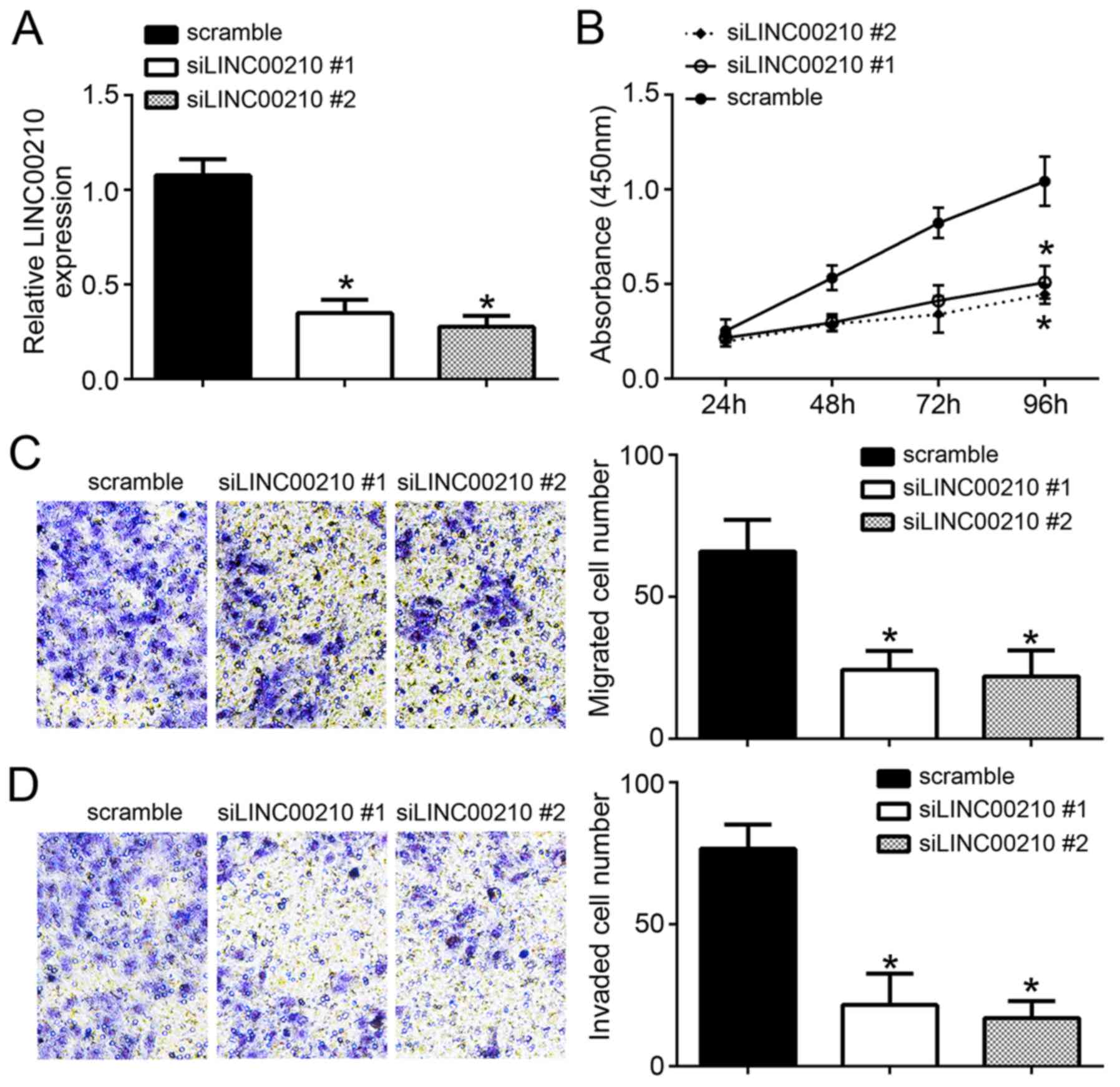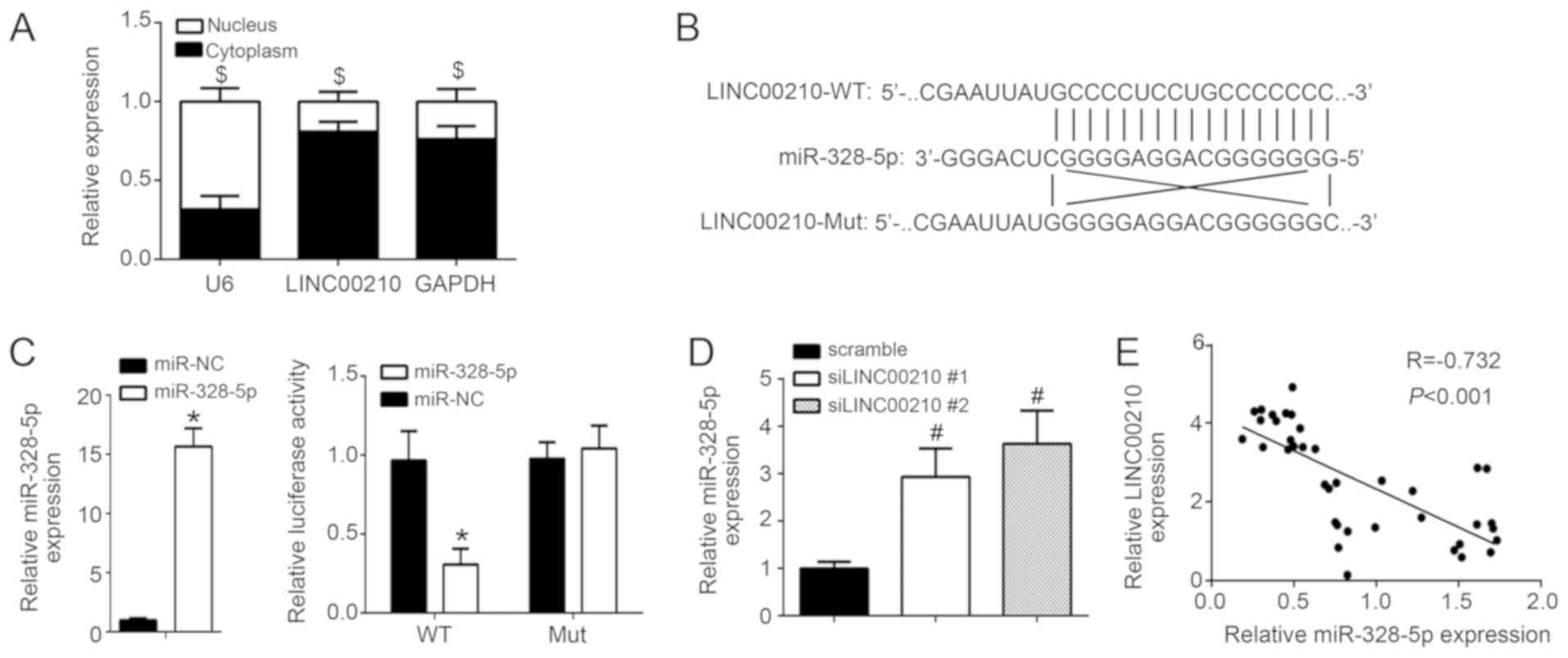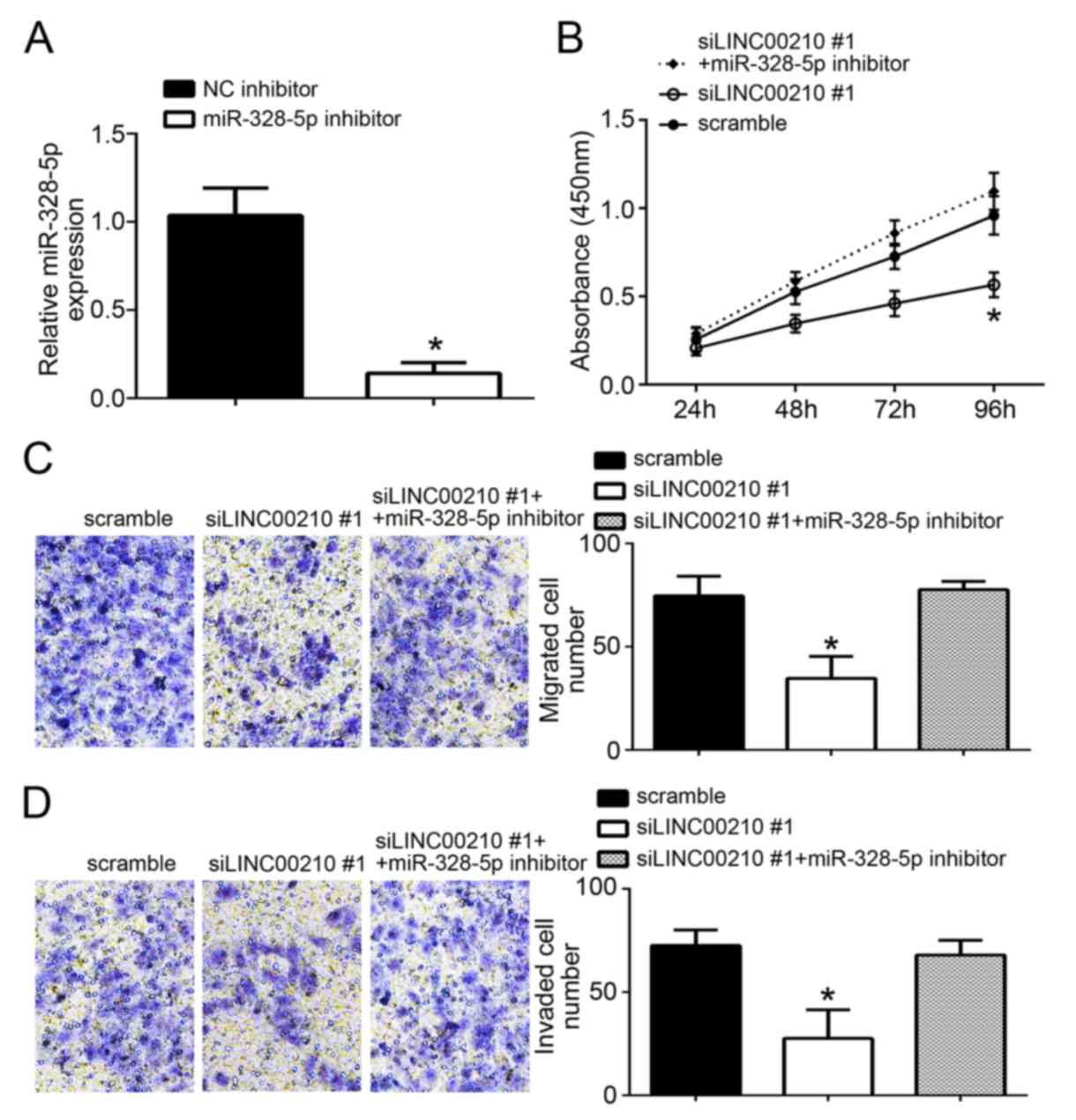|
1
|
Siegel RL, Miller KD and Jemal A: Cancer
statistics, 2017. CA Cancer J Clin. 67:7–30. 2017.PubMed/NCBI View Article : Google Scholar
|
|
2
|
Travis WD: The 2015 WHO classification of
lung tumors. Der Pathologe. 35 (Suppl 2)(S188)2014.
|
|
3
|
Meseure D, Drak Alsibai K, Nicolas A,
Bieche I and Morillon A: Long noncoding RNAs as new architects in
cancer epigenetics, prognostic biomarkers, and potential
therapeutic targets. Biomed Res Int. 2015(320214)2015.PubMed/NCBI View Article : Google Scholar
|
|
4
|
Yao Y, Li J and Wang L: Large intervening
non-coding RNA HOTAIR is an indicator of poor prognosis and a
therapeutic target in human cancers. Int J Mol Sci. 15:18985–18999.
2014.PubMed/NCBI View Article : Google Scholar
|
|
5
|
Liu Z, Sun M, Lu K, Liu J, Zhang M, Wu W,
Wei D, Wang Z and Wang R: The long noncoding RNA HOTAIR contributes
to cisplatin resistance of human lung adenocarcinoma cells via
downregualtion of p21 WAF1/CIP1 expression. PLoS One.
8(e77293)2013.PubMed/NCBI View Article : Google Scholar
|
|
6
|
Cheng N, Cai W, Ren S, Li X, Wang Q, Pan
H, Zhao M, Li J, Zhang Y, Zhao C, et al: Long non-coding
RNAUCA1induces non-T790M acquired resistance to EGFR-TKIs by
activating the AKT/mTOR pathway in EGFR-mutant non-small cell lung
cancer. Oncotarget. 6:23582–23593. 2015..v. PubMed/NCBI View Article : Google Scholar
|
|
7
|
Guo F, Jiao F, Song Z, Li S, Liu B, Yang
H, Zhou Q and Li Z: Regulation of MALAT1 expression by TDP43
controls the migration and invasion of non-small cell lung cancer
cells in vitro. Biochem Biophys Res Commun. 465:293–298.
2015.PubMed/NCBI View Article : Google Scholar
|
|
8
|
Wu D, Li Y, Zhang H and Hu X: Knockdown of
Lncrna PVT1 enhances radiosensitivity in non-small cell lung cancer
by sponging Mir-195. Cell Physiol Biochem. 42:2453–2466.
2017.PubMed/NCBI View Article : Google Scholar
|
|
9
|
Zhang S, Li P, Zhao L and Xu L: LINC00210
as a miR-328-5p sponge promotes nasopharyngeal carcinoma
tumorigenesis by activating NOTCH3 pathway. Biosci Rep.
38(BSR20181168)2018.PubMed/NCBI View Article : Google Scholar
|
|
10
|
Amin MB, Greene FL, Edge SB, Compton CC,
Gershenwald JE, Brookland RK, Meyer L, Gress DM, Byrd DR and
Winchester DP: The eighth edition AJCC Cancer Staging Manual:
Continuing to build a bridge from a population-based to a more
‘personalized’ approach to cancer staging. CA Cancer J Clin.
67:93–99. 2017.PubMed/NCBI View Article : Google Scholar
|
|
11
|
Livak KJ and Schmittgen TD: Analysis of
relative gene expression data using real-time quantitative PCR and
the 2(-Delta Delta C(T)) method. Methods. 25:402–408.
2001.PubMed/NCBI View Article : Google Scholar
|
|
12
|
Geng C, Ziyun W, Dongqing W, Chengxiang Q,
Mingxi L, Xing C, Qipeng Z, Guiying Y and Qinghua C: LncRNADisease:
A database for long-non-coding RNA-associated diseases. Nucleic
Acids Res. 41 (Database Issue):D983–D986. 2013.PubMed/NCBI View Article : Google Scholar
|
|
13
|
Li N, Wang Y, Liu X, Luo P, Jing W, Zhu M
and Tu J: Identification of circulating long noncoding RNA HOTAIR
as a novel biomarker for diagnosis and monitoring of non-small cell
lung cancer. Technol Cancer Res Treat. 16:1060–1066.
2017.PubMed/NCBI View Article : Google Scholar
|
|
14
|
Li S, Mei Z, Hu HB and Zhang X: The lncRNA
MALAT1 contributes to non-small cell lung cancer development via
modulating miR-124/STAT3 axis. J Cell Physiol. 233:6679–6688.
2017.PubMed/NCBI View Article : Google Scholar
|
|
15
|
Zhao Z, Wang J, Wang S, Chang H, Zhang T
and Qu J: LncRNA CCAT2 promotes tumorigenesis by over-expressed
Pokemon in non-small cell lung cancer. Biomed Pharmacother.
87:692–697. 2017.PubMed/NCBI View Article : Google Scholar
|
|
16
|
Huang Z, Lei W, Hu HB, Zhang H and Zhu Y:
H19 promotes non-small-cell lung cancer (NSCLC) development through
STAT3 signaling via sponging miR-17. J Cell Physiol. 233:6768–6776.
2018.PubMed/NCBI View Article : Google Scholar
|
|
17
|
Deng J, Liang Y, Liu C, He S and Wang S:
The up-regulation of long non-coding RNA AFAP1-AS1 is associated
with the poor prognosis of Patients with NSCLC. Biomed
Pharmacother. 75:8–11. 2015.PubMed/NCBI View Article : Google Scholar
|
|
18
|
Sun M, Liu XH, Lu KH, Nie FQ, Xia R, Kong
R, Yang JS, Xu TP, Liu YW, Zou YF, et al: EZH2-mediated epigenetic
suppression of long noncoding RNA SPRY4-IT1 promotes NSCLC cell
proliferation and metastasis by affecting the
epithelial-mesenchymal transition. Cell Death Dis.
5(e1298)2014.PubMed/NCBI View Article : Google Scholar
|
|
19
|
Lu KH, Li W, Liu XH, Sun M, Zhang ML, Wu
WQ, Xie WP and Hou YY: Long non-coding RNA MEG3 inhibits NSCLC
cells proliferation and induces apoptosis by affecting p53
expression. BMC Cancer. 13(461)2013.PubMed/NCBI View Article : Google Scholar
|
|
20
|
Han L, Kong R, Yin DD, Zhang EB, Xu TP and
De W Shu YQ: Low expression of long noncoding RNA GAS6-AS1 predicts
a poor prognosis in patients with NSCLC. Med Oncol.
30(694)2013.PubMed/NCBI View Article : Google Scholar
|
|
21
|
Mei Y, Si J, Wang Y, Huang Z, Zhu H, Feng
S, Wu X and Wu L: Long noncoding RNA GAS5 suppresses tumorigenesis
by inhibiting miR-23a 5 expression in non-small cell lung cancer.
Oncol Res. 25:1027–1037. 2017.PubMed/NCBI View Article : Google Scholar
|
|
22
|
Han L, Zhang E, Yin D, Kong R, Xu T, Chen
W, Xia R, Shu Y and De W: Low expression of long noncoding RNA
PANDAR predicts a poor prognosis of non-small cell lung cancer and
affects cell apoptosis by regulating Bcl-2. Cell Death Dis.
6(e1665)2015.PubMed/NCBI View Article : Google Scholar
|
|
23
|
Fu X, Zhu X, Qin F, Zhang Y, Lin J, Ding
Y, Yang Z, Shang Y, Wang L, Zhang Q and Gao Q: Linc00210 drives
Wnt/β-catenin signaling activation and liver tumor progression
through CTNNBIP1-dependent manner. Mol Cancer.
17(73)2018.PubMed/NCBI View Article : Google Scholar
|
|
24
|
Li J, Li Q, Huang H, Li Y, Li L, Hou W and
You Z: Overexpression of miRNA-221 promotes cell proliferation by
targeting the apoptotic protease activating factor-1 and indicates
a poor prognosis in ovarian cancer. Int J Oncol. 50:1087–1096.
2017.PubMed/NCBI View Article : Google Scholar
|
|
25
|
Santasusagna S, Moreno I, Navarro A, Muñoz
C, Martinez F, Hernández R, Castellano JJ and Monzo M: miR-328
mediates a metabolic shift in colon cancer cells by targeting
SLC2A1/GLUT1. Clin Transl Oncol. 20:1161–1167. 2018.PubMed/NCBI View Article : Google Scholar
|
|
26
|
Lin CH, Chiang MC and Chen YJ:
MicroRNA-328 inhibits migration and epithelial-mesenchymal
transition by targeting CD44 in nasopharyngeal carcinoma cells.
Onco Targets Ther. 11:2375–2385. 2018.PubMed/NCBI View Article : Google Scholar
|
|
27
|
Liu L, Chen RA, Zhang Y, Fan W, Xiao F and
Yan X: Low expression of circulating microRNA-328 is associated
with poor prognosis in patients with acute myeloid leukemia. Diagn
Pathol. 10(109)2015.PubMed/NCBI View Article : Google Scholar
|
|
28
|
Yuan J, Zheng Z, Zheng Y, Lu X, Xu L and
Lin L: microRNA-328 is a favorable prognostic marker in human
glioma via suppressing invasive and proliferative phenotypes of
malignant cells. Int J Neurosci. 126:145–153. 2016.PubMed/NCBI View Article : Google Scholar
|
|
29
|
Wu Z, Sun L, Wang H, Yao J, Jiang C, Xu W
and Yang Z: MiR-328 expression is decreased in high-grade gliomas
and is associated with worse survival in primary glioblastoma. PLoS
One. 7(e47270)2012.PubMed/NCBI View Article : Google Scholar
|
|
30
|
Ma W, Ma CN, Zhou NN, Li XD and Zhang YJ:
Up-regulation of miR-328-3p sensitizes non-small cell lung cancer
to radiotherapy. Sci Rep. 6(31651)2016.PubMed/NCBI View Article : Google Scholar
|


















